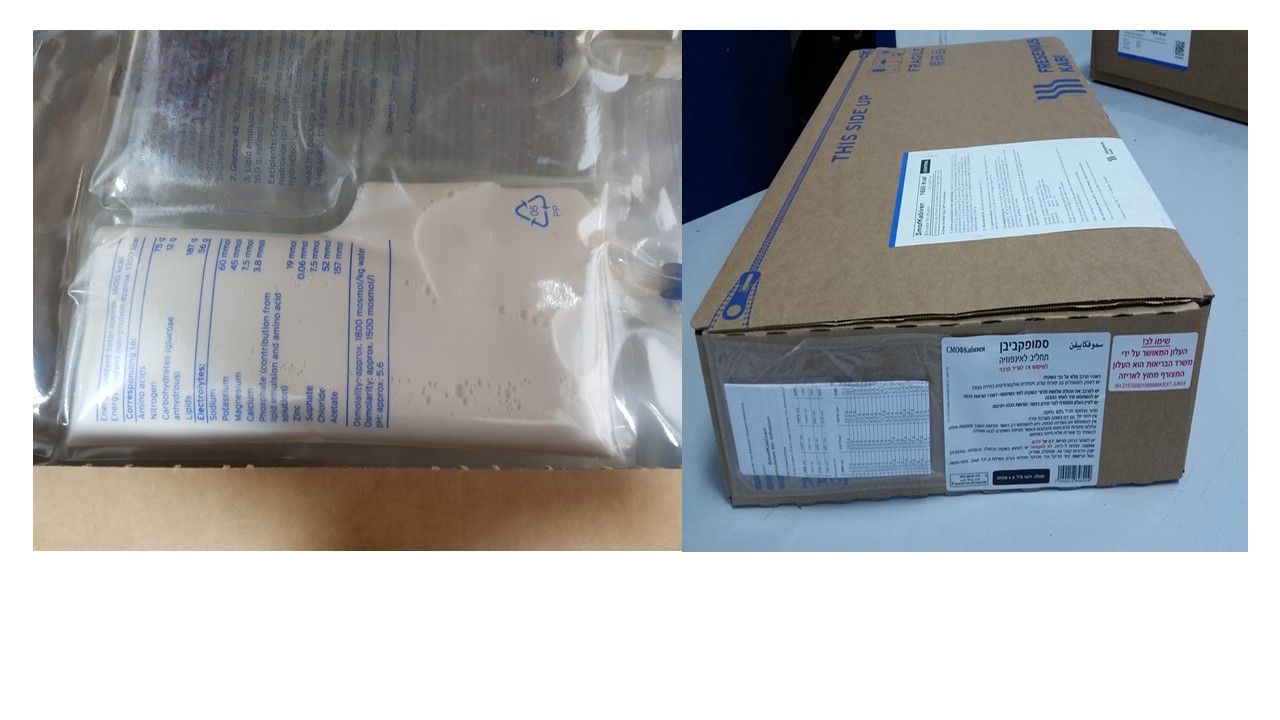Quest for the right Drug

סמופקביבן SMOFKABIVEN (AMINOACETIC ACID, CALCIUM CHLORIDE DIHYDRATE, FISH OIL, GLUCOSE MONOHYDRATE, L- ALANINE, L- ISOLEUCINE, L- LEUCINE, L- LYSINE ACETATE, L- METHIONINE, L- PHENYLALANINE, L- PROLINE, L- SERINE, L- THREONINE, L- TRYPTOPHAN, L- TYROSINE, L- VALINE, L-ARGININE, L-HISTIDINE, MAGNESIUM SULFATE HEPTAHYDRATE, OLIVE OIL, POTASSIUM CHLORIDE, SODIUM ACETATE TRIHYDRATE, SODIUM GLYCEROPHOSPHATE HYDRATE, SOYBEAN OIL, TAURINE, TRIGLYCERIDES, MEDIUM-CHAIN, ZINC SULFATE HEPTAHYDRATE)
צורת מתן:
תוך-ורידי : I.V
צורת מינון:
תחליב לאינפוזיה : EMULSION FOR INFUSION
עלון לרופא
מינוניםPosology התוויות
Indications תופעות לוואי
Adverse reactions התוויות נגד
Contraindications אינטראקציות
Interactions מינון יתר
Overdose הריון/הנקה
Pregnancy & Lactation אוכלוסיות מיוחדות
Special populations תכונות פרמקולוגיות
Pharmacological properties מידע רוקחי
Pharmaceutical particulars אזהרת שימוש
Special Warning עלון לרופא
Physicians Leaflet
Pharmacological properties : תכונות פרמקולוגיות
Pharmacodynamic Properties
5.1 Pharmacodynamic properties Pharmacotherapeutic group: Solutions for parenteral nutrition. ATC code: B05BA10 Lipid emulsion The lipid emulsion of SmofKabiven is composed of Smoflipid and has a particle size and biological properties similar to those of endogenous chylomicrons. The constituents of Smoflipid; soya-bean oil, medium-chain triglycerides, olive oil and fish oil have except for their energy contents, their own pharmacodynamic properties. Soya-bean oil has a high content of essential fatty acids. The omega-6 fatty acid linoleic acid is the most abundant (approx. 55-60%). Alpha-linolenic acid, an omega-3 fatty acid, constitutes about 8 %. This part of SmofKabiven provides the necessary amount of essential fatty acids. Medium-chain fatty acids are rapidly oxidised and provide the body with a form of immediately available energy. Olive oil mainly provides energy in the form of mono-unsaturated fatty acids, which are much less prone to peroxidation than the corresponding amount of poly-unsaturated fatty acids. Fish oil is characterised by a high content of eicosapentaenoic acid (EPA) and docosahexaenoic acid (DHA). DHA is an important structural component of cell membranes, whereas EPA is a precursor of eicosanoids as prostaglandines, thromboxanes and leucotrienes. Two studies providing home parenteral nutrition in patients in need of long-term nutrition support have been performed. The primary objective in both studies was to show safety. Efficacy was the secondary objective in one of the studies, which was done in paediatric patients. This study was stratified by age groups (1 month-<2 years, and 2–11 years respectively). Both studies showed that Smoflipid has the same safety profile as the comparator (Intralipid 20%). Efficacy in the paediatric study was measured by weight gain, height, body mass index, pre-albumin, retinol binding protein and fatty acid profile. There was no difference between the groups in any of the parameters except the fatty acid profile after 4 weeks treatment. The fatty acid profile in the Smoflipid patients revealed an increase in omega-3 fatty acids in plasma lipoproteins and red blood cells phospholipids and hence reflects the composition of the infused lipid emulsion. Amino acids and electrolytes The amino acids, constituents of protein in ordinary food, are utilised for tissue protein synthesis and any surplus is channelled to a number of metabolic pathways. Studies have shown a thermogenic effect of amino acid infusion. Glucose Glucose should have no pharmacodynamic effects apart from contributing to maintain or replete the normal nutritional status.
Pharmacokinetic Properties
5.2 Pharmacokinetic properties Lipid emulsion The individual triglycerides in Smoflipid have different clearance rate but Smoflipid as a mixture is eliminated faster than long chain triglycerides (LCT). Olive oil has the slowest clearance rate of the components (somewhat slower than LCT) and medium chain triglycerides (MCT) the fastest. Fish oil in a mixture with LCT has the same clearance rate as LCT alone. Amino acids and electrolytes The principal pharmacokinetic properties of the infused amino acids and electrolytes are essentially the same as for amino acids and electrolytes supplied by ordinary food. However, the amino acids of dietary protein first enter the portal vein and then the systemic circulation, while intravenously infused amino acids reach the systemic circulation directly. Glucose The pharmacokinetic properties of infused glucose are essentially the same as those of glucose supplied by ordinary food.

מידע נוסף
עלון מידע לרופא
03.12.20 - עלון לרופאעלון מידע לצרכן
03.12.20 - החמרה לעלוןלתרופה במאגר משרד הבריאות
סמופקביבן